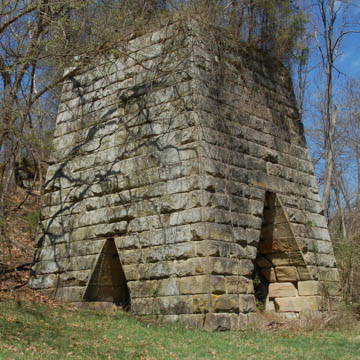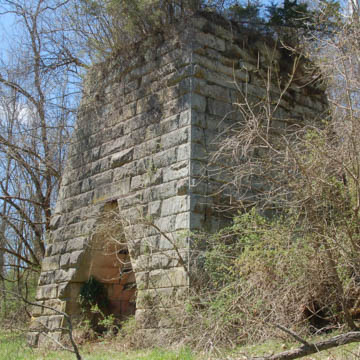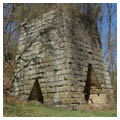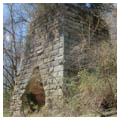The Oak Ridge Furnace is representative of the nearly 70 charcoal iron furnaces that once dotted the Hanging Rock Iron Region of southern Ohio and northern Kentucky. During the early to mid-nineteenth century, iron making was an important industry in the region, which contained abundant quantities of sandstone and clay for furnace construction, and iron ore, limestone, and charcoal for making the iron. At the time this furnace was built the ores of the Hanging Rock Region were regarded as among the best in the nation in terms of quality. The armor for the famous Union ironclad steamship, the “Monitor,” came from this region. The Oak Ridge Furnace is one of the most intact examples of the dozen or so remaining blast furnace stacks in Ohio.
This furnace was constructed by W. H. Allison, a furnace builder living in nearby Ironton. In 1856 Professor W.W. Mather (the first state geologist of Ohio) and Professor (later Major General) O.M. Mitchell commissioned Allison to build the furnace and work was completed the following year, when it was first put into blast. The location and construction of the furnace, which produced 15 tons of iron per day, was selected in anticipation of a railroad spur that was never realized. This made transportation of the iron difficult and the Oak Ridge Furnace went out of blast a year later in 1858. Such a brief period of operation kept this furnace stack in a much better state of preservation than those subjected to years or even decades of intense heat generated by continuous blasts.
As with iron furnaces across Ohio (one exception is the reconstructed Buckeye Furnace), nothing remains at Oak Ridge except the stack. With their volcano-like glow, the furnace stacks were always the most prominent features of a blast operation, making the stacks iconic symbols of the early iron industry in the region. The Oak Ridge Furnace was constructed in a pattern similar to the others across the region. The large stone chimney, constructed of cut sandstone quarried from nearby cliffs, measures nearly 40 feet high and is approximately 32 square feet at the base, gradually tapering at a 10-degree angle from the ground to the top of the stack. The ashlar sandstone blocks were set without the use of mortar, a substance that could not withstand the intense heat generated within the stack. The hollow interior contains a fire brick lining covered with fire clay that is separated from the exterior sandstone by a thin layer of rubble insulation. Like the stack exterior, the interior lining is also tapered. The widest portion at the bottom forms a bowl-like shape known as a bosh, which is the melting zone for the ore. The large opening at the top is where the iron ore, charcoal, and limestone were dumped into the furnace from a charging deck that connected the top of the stack to the bluff at the rear. The large triangular opening on the front of the furnace was utilized for extracting the molten iron ore from the bosh and directing it into the casting shed that was once situated in front of the furnace. In this shed, the pig iron was formed and readied for transport. The sides of the furnace contain smaller triangular openings that housed the tuyeres, apparatuses that introduced oxygen into the stack to increase the heat in order to bring the ore to a molten state.
As higher quality ores were identified elsewhere in the nation, the iron industry in Ohio began a gradual decline. This was hastened by the depletion of the forest stands around the state’s charcoal furnaces, which lead to their replacement with coke-fueled furnaces. Technological advances dealt the final blow when the introduction of the Bessemer blast furnaces made the charcoal iron furnaces obsolete. The charcoal iron furnaces that once played an important role in the early development of iron in the Hanging Rock Iron Region were eventually abandoned and all that remains of this once significant industry are a few furnace stacks such as the one at Oak Ridge Furnace.
References
Mitchell, John. “Hanging Rock Pig.” Ohio Magazine9 1989:124-129, 141-142.
Rist, Donald. Iron Furnaces of the Hanging Rock Iron Region.Ashland, KY: Hanging Rock Press, 1974.
Stout, Wilbur. “The Charcoal Iron Industry of the Hanging Rock Iron District: Its Influence on the Early Development of the Ohio Valley.” Ohio Archaeological and Historical Quarterly42, No 1 (1933): 72-104.
Willard, Eugene. A Standard History of the Hanging Rock Iron Region of Ohio. 2 Vols. Chicago: Lewis Publishing Company, 1916.




